#globicephala
Text

Southern long-finned pilot whale Globicephala melas edwardii
Observed by oscarkokako, CC BY-NC-ND
#Globicephala melas edwardii#southern long-finned pilot whale#Cetacea#Delphinidae#cetacean#dolphin#whale#Oceania#New Zealand#Pacific Ocean
23 notes
·
View notes
Note
Hi, This is sooo so very cool, I’m in the middle of my final exams right now and every so often I forget why I love biology, and chemistry and then I think dammit I should have just picked languages as my high level courses. But whenever I see your blog, I am reminded of why I want to study biochemistry. It’s just so insanely cool. Anyways, you don’t have to answer, but I just wanted to let you know. Many thanks!!!!
String identified:
, T c, ’ t a a gt a t gt g, a ct a t t at a t c agag a g c. t g, a at t t ct. t’ t a c. Aa, ’t a t a, t t at t t . a ta!!!!
Closest match: Globicephala melas genome assembly, chromosome: 19
Common name: Long-finned pilot whale (dolphin)

#tumblr genetics#genetics#the-name-was-lost#asks#YOOO FIRST DOLPHIN!!!#dolphins#also it makes me so happy to hear that this blog gets you excited about science again#i've almost quit several times. shit sucks#but it makes me so happy to see real scientists and students find joy in this silly little blog#you gotta push through. for the aminals#for the long-finned pilot whale (which is actually a dolphin)
652 notes
·
View notes
Text

Meet the long-finned pilot whale (Globicephala melas)! Reaching lengths of up to 25 feet (7.6 meters), it's the second largest member of the dolphin family; the orca is the largest. This nomadic cetacean is widely distributed, and can be seen throughout the oceans of the Southern Hemisphere. It wanders in search of food such as squid, fish, mollusks, and other sea critters. This species is highly social, with family units called pods consisting of up to 100 members. Pilot whales have even been observed participating in multi-pod gatherings with more than 1,000 individuals congregating at once!
Photo: titouan_roguet, CC BY-NC 4.0, iNaturalist
#science#nature#natural history#animals#mammal#whales#pilot whale#did you know#fact of the day#ocean life#dolphin#cetacean
383 notes
·
View notes
Text

Long-Finned Pilot Whale (South Emisphere Form)
Globicephala melas edwardii)
Family: Delphinidae
Genus: Globicephala
Status and Conservation: Least Concern
This is the final subspecies in this small family, and they closely resemble each other. Distinguishing them requires expertise. This form, for instance, exhibits more prominent white stripes on its sides and top compared to the other subspecies, though the presence of this pattern is not exclusive to it. This form resides in the Southern Ocean near the Antarctic Pole, as its name suggests.
__________________________
Please consider joining the club where you can find more detailed information about every post here, spreads of the book that is in the making, and have access to the collectible E-Stickers.
Just click here
#long finned pilot whale#pilot whales#dolphin#whale#illustration#drawing#scientific illustration#illo#wild animals#wildlife#sea mammals#sea monsters#artist on tumblr#animals#mammals#animal
37 notes
·
View notes
Text

Grzimek's Animal Life Encyclopedia, vol. 11, Mammals II. 1972. Illustrated by Peter Barrett.
Beaked whales;
1.) Baird's beaked whale (Berardius bairdii)
2.) Strap-toothed whale (Mesoplodon layardii)
3.) True's beaked whale (Mesoplodon mirus)
4.) Sowerby's beaked whale (Mesoplodon bidens)
5.) Northern bottlenose whale (Hyperoodon ampullatus)
White whales and narwhals;
6.) Beluga whale (Delphinapterus leucas)
7.) Narwhal (Monodon monoceros)
Long snouted dolphins;
8.) Rough-toothed dolphin (Steno bredanensis)
9.) Atlantic humpback dolphin (Sousa teuszii)
True dolphins;
10.) Indo-Pacific bottlenose dolphin (Tursiops aduncus)
11.) Common dolphin (Delphinus delphis)
12.) Striped dolphin (Stenella coeruleoalba)
13.) Atlantic white-sided dolphin (Lagenorhynchus acutus)
14.) Common bottlenose dolphin (Tursiops truncatus)
15.) Risso's dolphin (Grampus griseus)
16.) Northern right whale dolphin (Lissodelphis borealis)
Pilot and killer whales;
17.) Long-finned pilot whale (Globicephala melas)
18.) Pygmy killer whale (Feresa attenuata)
19.) Irrawaddy dolphin (Orcaella brevirostris)
20.) Orca (Orcinus orca)
21.) False killer whale (Pseudorca crassidens)
Commerson's dolphins;
22.) Commerson's dolphin (Cephalorhynchus commersonii)
Porpoises;
23.) Harbour porpoise (Phocoena phocoena)
24.) Spectacled porpoise (Phocoena dioptrica)
25.) Dall's porpoise (Phocoenoides dalli)
26.) Indo-Pacific finless porpoise (Neophocaena phocaenoides)
#cetaceans#beaked whales#baird's beaked whales#strap-toothed whales#true's beaked whales#sowerby's beaked whales#northern bottlenose whales#belugas#narwhals#dolphins#rough-toothed dolphins#atlantic humpback dolphins#indo-pacific bottlenose dolphins#common dolphins#striped dolphins#atlantic white-sided dolphins#common bottlenose dolphins#risso's dolphins#northern right whale dolphins#pilot whales#long-finned pilot whales#pygmy killer whales#irrawaddy dolphins#orcas#false killer whales#commerson's dolphins#porpoises#harbour porpoises#spectacled porpoises#dall's porpoises
267 notes
·
View notes
Text
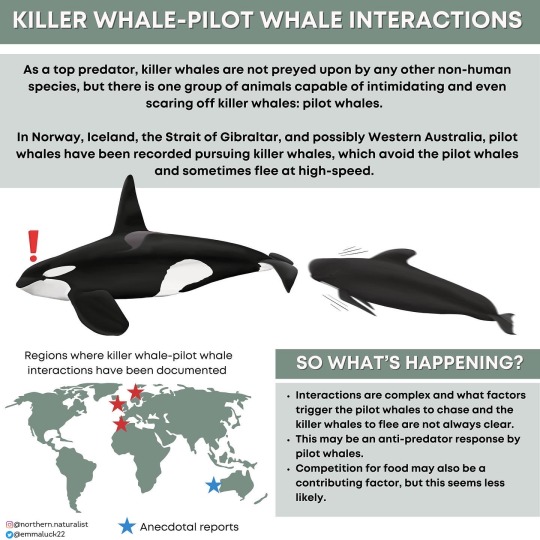
There’s not much that scares a killer whale. After all, it is a top predator capable of feeding on virtually any animal in the ocean. But there is one creature that can intimidate even killer whales—pilot whales.
In various parts of the world, long-finned pilot whales have been documented approaching and even chasing groups of killer whales. These interactions have occurred in Norway, Iceland, Spain, and there are anecdotal reports from Australia. Pilot whales may come charging into the area, harassing and pursuing a group of killer whales, which often respond by moving away and even fleeing at high speeds. I’ll never forget the day in Norway a few years ago when I was stuck at the house, unable to head out on the water for observations. On that particular day, a massive group of pilot whales appeared in the fjords, and the killer whales in the area all vanished for the rest of the day. The pilot whales had left by the following morning, and we managed to find a few killer whales that had returned, but it certainly gave me a lot to think about.
Curiously, pilot whales are attracted to killer whale calls, and upon hearing them, will respond by approaching the source of the sound, which may explain why they sometimes seemingly appear out of nowhere and start chasing the killer whales. Scientists suggest this behavior could be an anti-predator response to killer whales. Aggressively approaching the killer whales may be pilot whales’ way of saying “Hey, I can see you, get away from here!” There also may be some aspect of food competition, but this seems like a less likely reason as the diet of pilot whales and killer whales do not always overlap.
Another potentially important piece of this puzzle was revealed earlier this year when researchers in Iceland documented a tiny newborn pilot whale traveling with a pod a killer whales, with no other pilot whales in sight. Are killer whales calf-napping baby pilot whales?! There’s still much to be learned about these interactions.
References:
Curé C, Antunes R, Samarra F, Alves AC, Visser F, Kvadsheim PH, Miller PJO (2012) Pilot whales attracted to killer whale sounds: acoustically-mediated interspecific interactions in cetaceans. PLoS ONE 7:e52201.
Selbmann, A., Basran, C.J., Bertulli, C.G. et al. (2022) Occurrence of long-finned pilot whales (Globicephala melas) and killer whales (Orcinus orca) in Icelandic coastal waters and their interspecific interactions. acta ethol 25, 141–154
100 notes
·
View notes
Text
creature of the week: these fuckers

orcinus orca, commonly referred to as orcas or killer whales, are found fucking everywhere except for the arctic ocean, and specific and/or obvious spots such as the great lakes and the mediterranean sea.
they are a species of toothed whale in the family delphinidae, which means they're cousins with things like the bottlenose dolphin (tursiops truncatus) and the long-finned pilot whale (globicephala melas).

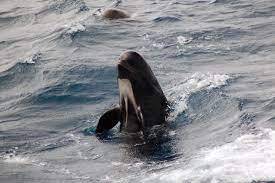
these sons of bitches had the audacity to be a god damn apex and eat stuff like fish, sharks (we'll come back to that in a minute), rays, seals, cephalopods, seabirds, sea turtles and other dolphin/whale species. they also hunt in packs because why fucking not. this got them the nickname "wolves of the sea".
with the fact that they eat sharks, this includes the god damn great white. they flip em over, and rip out their fucking liver.
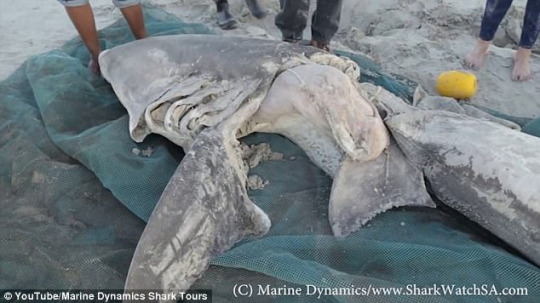
if you've noticed, i've been very harsh on these guys. i actually think they're really cool animals, and the fact that they have the black air force energy to pull this shit radiates big mood imo. they have the 2nd largest brain of any sea creature, only behind the sperm whale. i love these creatures, and would love to see them in their pods in the wild. they also really annoy me tho. i'm sorry but a shark-harassing honey badger dolphin does not deserve to be an apex. ignoring that they're an apex predator, they're at least in my top 15, maybe even top 10. that's why i gave them the honor of being my first creature of the week.
7 notes
·
View notes
Text
About Tasman Sea, facts and maps
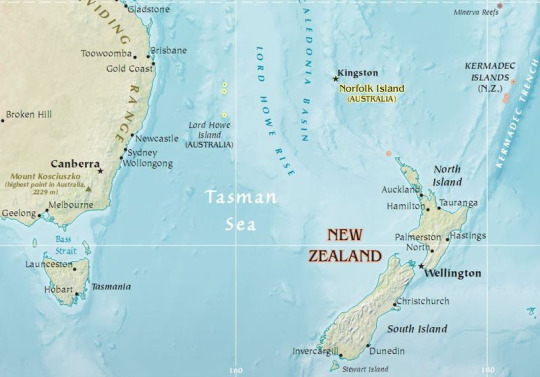
The sea was named for the Dutch navigator Abel Tasman, who navigated it in 1642. Its New Zealand and Australian shorelines were explored in the 1770s by the British mariner Captain James Cook and others. With maximum depth exceeding 17,000 feet (5,200 m), the seafloor's most distinctive feature is the Tasman Basin. Yes, the Tasman Sea is part of the South Pacific Ocean. It is what is termed a marginal sea, meaning it is a simply division of an ocean. It is bounded to the west by Australia, the east by New Zealand, and the north by the Coral Sea.
The basin countries for the Sea are Australia and New Zealand, with several major cities lying on the Tasman Sea's coast. The region is primarily shaped by the Tasman's underwater mid-ocean ridge that formed 85 – 55 million years ago.

The Tasman Sea is a difficult and dangerous sea for sailors. Known as “the Ditch”, the Tasman Sea is notorious for being unpredictable and prone to storms. Many people have lost their lives making the crossing and ships have disappeared completely, leaving no trace.
It is regarded by many sailors as being one of the most dangerous stretches of water in the world. Unlike many other bodies of water, wind and wave conditions on the Tasman Sea are rough for most of the year as the currents of the Southern Ocean collide with those of the Pacific. The Tasman Sea is 2,250 km (1,400 mi) wide and has an area of 2,300,000 km2 (890,000 sq mi). The maximum depth of the sea is 5,943 m (19,498 ft). The sea water on the east coast of Tasmania, Australia - from which Tasman Sea Salt is harvested - is of the highest quality, meaning that the salt does not need to be cleaned or rinsed during the production process.

What creatures live in the Tasman Sea? Frequently seen whales and dolphins in Tasmania
- Long-finned pilot whale, Globicephala melaena.
- Common dolphin, Delphinus delphis.
- Sperm whale, Physeter catodon.
- Bottle-nosed dolphin, Tursiops truncatus.
- Killer whale, Orcinus orca.
Which ocean is toxic?
The waters most seriously impacted by ocean pollution are the Mediterranean Sea, the Baltic Sea, and Asian rivers.
What beach has the most deaths?
With a score of 8.14 out of 10, the most dangerous beach in America, according to Travel Lens, is New Smyrna Beach, Florida. Since 2010, the area has seen 10 surf zone fatalities and 32 reported shark attacks. In addition, 120 hurricanes impacted the area between 1851 and 2020.
Is the Tasman Sea always rough?
The short answer is yes, the Tasman Sea is notoriously known to seafarers as almost always rough. There is a window during the summer months from November to March when the seas would not be as rough as during the winter months. However, it could easily change with the variable weather.
What country is Tasman Sea in?
The Tasman Sea is a Sea region of the Pacific Ocean. Located on the East coast of Australia, the Tasman Sea is bounded by Sydney.
How long does it take to sail the Tasman Sea?
Depending on your boat speed and conditions, this trip is typically one to two weeks long, and the most popular time to make this trip is during the southern hemisphere summer (November through May).
Does Tasman have snow?
The city rarely receives snow in winter; however, the adjacent Mount Wellington is often seen with a covering in winter, and it has received unseasonal snowfalls in all seasons, including summer.
Why is Tasmania colder than the rest of Australia?
Tasmania is Australia's coldest state overall because it is closer to the polar zone compared to the other Australian states and territories, and experiences more frequent bursts of cold Antarctic air. The coldest nights occur when the conditions are clear and calm, especially if there is snow cover.
Does New Zealand have killer whales?
They prefer deeper water but can be found in shallow bays and estuaries, and in inland seas. Orca can be found all throughout New Zealand's coastline.

Read the full article
#AretheremanysharkattacksinTasmania?#AretheresharksintheTasmanSea?#AretherewhalesintheTasmanSea?#CanyoucrosstheTasmanSea?#CanyouswiminTasmanLake?#CanyouswimwithwhalesinNewZealand?#DopeopleliveonTasmanisland?#DoesNewZealandhavekillerwhales?#DoesTasmanhavesnow?#HasanyonecrossedtheTasmanSeainakayak?#HowcoldistheTasmanSea?#HowdeepisTasmanSea?#HowlongdoesittaketosailtheTasmanSea?#IstheTasmanSeaalwaysrough?#IstheTasmanSeaSaltwater?#IstheTasmanSeasalty?#Whatarethedeadliestseasintheworld?#Whatbeachhasthemostdeaths?#WhatcountryisTasmanSeain?#WhatcreaturesliveintheTasmanSea?#Whatisthedeadliestoceanintheworld?#WhatisthedifferencebetweenPacificOceanandtheTasmanSea?#WhatistheTasmanSeaknownfor?#Whatkillsthemosthumansintheocean?#Whereisthesafestplacetoswimwithsharks?#Whichoceanistoxic?#WhichtwocountriesareseparatedbytheTasmanSea?#WhoownstheTasmanSea?#WhyaretheykillingsharksinNewZealand?#WhyisTasmaniacolderthantherestofAustralia?
0 notes
Text
Webyep review

(eds.) Conference Programme & Proceedings of the 11th Annual Conference of the International Competence Network of Tourism Research and Education (ICNT): Ecotourism in the 21st Century, 15.-17. (2017) Swimming with wild orcas in Norway: Killer whale behaviours addressed towards snorkelers and divers in an unregulated whale watching market. Report to the Department of Agriculture, Environment and Rural Areas (LLUR) of Schleswig-Holstein. (2017) Grey seals and tourism on the island of Helgoland. pdf.)Ĭonference presentations, thesis and reports van Neer, A., Scheer, M. New York, U.S.A.: Nova Science Publishers, Inc. Samuels (Ed.) Dolphins: Ecology, Behavior and Conservation Strategies (pp. (2014) Behaviors of botos and short-finned pilot whales during close encounters with humans: management implications derived from ethograms for food-provisioned versus unhabituated cetaceans. (Ed.) Encounters with Whales – A Survey of Human/Whale Culture ( …e-book.) (2018) German scientists meet pilot whales. Insights from the International Competence Network of Tourism Research and Education (ICNT). (Eds.): A kaleidoscope of tourism research, pp. (2021) Swimming with wild orcas in Norway: killer whale behaviours addressed towards snorkelers and divers in an unregulated whale watching market. (2004) Underwater behaviors of short-finned pilot whales (Globicephala macrorhynchus) off Tenerife. (2004) Ethogram of selected behaviors initiated by free-ranging short-finned pilot whales (Globicephala macrorhynchus) and directed to human swimmers during open water encounters. (2010) Review of self-initiated behaviors of free-ranging cetaceans directed towards human swimmers and waders during open water encounters. (2013) Call vocalizations recorded among short-finned pilot whales (Globicephala macrorhynchus) off Tenerife, Canary Islands. (2017) True's beaked whales in Macaronesia. pdf.)Īguilar de Soto, N., Martín, V, Silva, M.A., Edler, R., Reyes, C., Carrillo, M, Schiavi, A., Morales, T., García-Ovide, B., Sánchez, A., García-Tavero, N., Steiner, L., Scheer, M., Gockel, R., Walker, D., Villa, E., Szlama, P., Eriksson, I.K., Tejedor, M., Pérez Gil, M., Quaresma, J., Bachara, W. (2017) Swim encounters with killer whales (Orcinus orca) off northern Norway: interactive behaviours directed towards human divers and snorkellers obtained from opportunistic underwater video recordings. (2018) A rejoinder to comments on ‘Swim encounters with killer whales (Orcinus orca) off northern Norway: interactive behaviours directed towards human divers and snorkellers obtained from opportunistic underwater video recordings’. (2020) Behaviors of grey seals (Halichoerus grypus) addressed towards human swimmers during experimental open water encounters off Heligoland (German Bight, North Sea).

0 notes
Text
Final Major Project (FMP)
Marine Mammals
The first animals moved from the sea to colonise the land several million years ago. Global changes in climate and geography eventually convinced some of the mammals to return to the sea. Since then, these animals have evolved to be perfectly adapted to their surroundings. The majority of these animals are classified as cetaceans, which includes dolphins and whales. The other major group of marine mammals is the pinniped family, which includes seals and sea lions. Cetaceans can hold their breath for unimaginable lengths of time after breathing air and then diving. They are both peaceful and intelligent animals. Some of the largest brains in the world of mammals are found in the oceans. These animals have demonstrated remarkable communication and learning abilities. In the wild, they live in close family groups, caring for their young and each other. Their songs reverberate for miles beneath the waves. It is disheartening to think that most of these magnificent animals were hunted to extinction by humans. Today, however, they are returning under the protection of the majority of the world's governments. Their ambassadors help to save their kind by helping us better understand them in marine parks all over the world. The following is a list of some of the world's more well-known marine mammals.
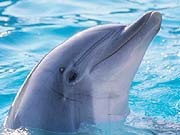
Photo © Corel Corporation
Atlantic Bottlenose Dolphin
(Tursiops melaena)
The bottlenose dolphin is one of the most well-known sea mammals. Their gentle nature has warmed our hearts. These highly social animals have been known to save humans in danger. They are intelligent creatures with brains comparable to ours. Some scientists believe they have complex communication abilities.

Photo © Corel Corporation
Atlantic Spotted Dolphin
(Stenella frontalis)
Except for the visible body spots, the Atlantic spotted dolphin resembles the bottlenose dolphin. They are generally smaller than their relatives. They travel in close family groups called pods, as do all dolphins.

Photo © Corel Corporation
Pilot Whale
(Globicephala melaena)
The pilot whale is a small member of the whale family, measuring approximately 10 feet in length. They are perhaps best known for mass strandings, where entire pods of these animals beach themselves in an apparent suicide attempt. This behaviour is still unknown.
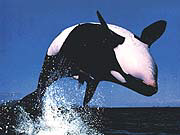
Photo © Corel Corporation
Killer Whale
(Orcinus orca)
Shamu, the killer whale from "Free Willy," is a highly intelligent and sociable animal. Most marine parks have it as a standard attraction. Orca pods have been observed cooperating when hunting for food. They will even beach themselves temporarily in order to catch one of their favourite foods, the sea lion.
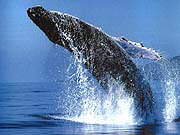
Photo © Corel Corporation
Humpback Whale
(Megaptera novaeangliae)
The humpback whale is a large animal that can grow to be 60 feet long. These magnificent creatures were hunted to the brink of extinction, but are now making a comeback. They eat plankton and are best known for their enchanting song, which can be heard for hundreds of miles beneath the sea.

Photo © Corel Corporation
Pacific Gray Whale
(Eschrichtius robustus)
Gray whales are one of the most well-known large whales. They are frequently seen swimming along the western coasts. These animals, which have long been endangered, are only now beginning to recover from overhunting. They can reach 50 feet in length and are frequently covered in barnacle patches.

Photo © Corel Corporation
West Indian Manatee
(Trichechus manatus)
Manatees are graceful and serene animals. They feed on water plants and live in Florida's waterways and shores. Other species can be found in the Indian and Gulf of Mexico. They are slow-moving creatures that are on the verge of extinction due to careless boaters. Most manatees have boat motor scars on their backs.

Photo © Corel Corporation
California Sea Lion
(Zalophus californianus)
Sea lions are probably the best-known members of the pinniped family. They inhabit the western coast of the United States and Canada. These animals are clumsy on land, but underwater their graceful ballets can reach speeds of 25 mph. They can dive to over 1000 feet, where they feed primarily on fish and squid.
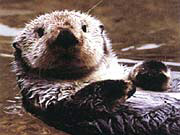
Photo © Corel Corporation
Sea Otter
(Enhydra lutris)
These adorable creatures were once hunted to extinction for their fur. They used to live in the western United States' coastal waters, but they are now protected and making a comeback. They are frequently seen lying on their backs eating their preferred food, crustaceans.
0 notes
Text
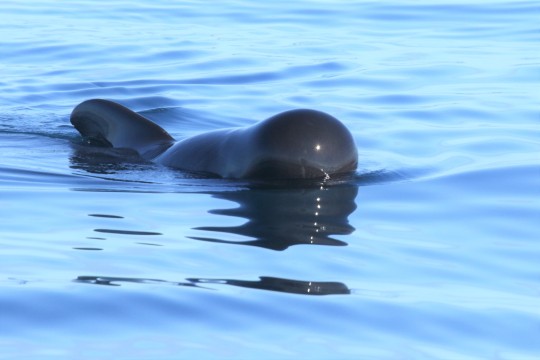
Shiho short-finned pilot whale Globicephala macrorhynchus ssp.
Observed by mariobird, CC BY-NC
Short-finned pilot whales Globicephala macrorhynchus are found worldwide in tropical and temperate waters. Recently, two subspecies were defined. The Shiho short-finned pilot whale has not yet received a formal scientific name, pending genetic sampling of historic museum specimens to see if the Shiho form can be attributed to an already-named form of pilot whale. The Shiho short-finned pilot whale is found in cool waters from Japan to California and as far south as Peru. In general, this subspecies is the larger of the two, with a plainer black coloration and an especially rounded, bulbous melon in adult males, as seen here.
#Globicephala macrorhynchus ssp.#Shiho short-finned pilot whale#Cetacea#Delphinidae#cetacean#dolphin#whale#North America#United States#California#Pacific Ocean#keep reading
16 notes
·
View notes
Photo
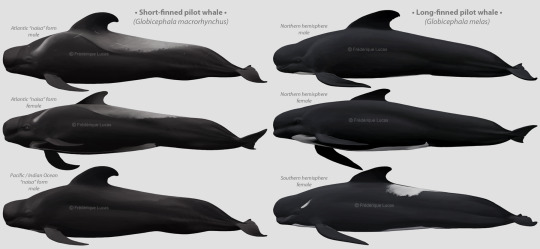
A plethora of pilot whales
The alliterations continue, as well as the uploading of illustrations from last year’s two big project. This time, pilot whales. A big and impressive relative of the killer whale, which come in two species: the Long-finned (Globicephala melas) and Short-finned (Globicephala macrorhynchus). Ironically pectoral fin length isn’t always a good identifier, but shape is a good call: in Short-fins the pectoral fins have a continuous sickle shape, whereas in Long-fins the pectoral fins have a single bend, and then taper out very straight.
Within the species there is diversity too. Long-finned pilot whales are the colder water species of the two, and thus their range is divided into a northern and southern population. Northern animals are quite plain black aside from the white anchor marking on their chest and belly. However Southern animals bear very striking white eye- and saddle patches, a bit reminiscent of killer whales.
Short-finned pilot whales live in warmer waters and Japanese fishermen had long known of two different types. Recent research showed these to be two distinct global subspecies: the “Shiho” form, living mostly in the Eastern Pacific but also off Northern Japan, and the “Naisa” form, living in the rest of the Pacific Ocean, as well as the Indian and Atlantic. They can be told apart by their saddle patch: the Naisa form has a long saddle patch reaching almost the end of the peduncle, whereas the Shiho form has a very short one. I only illustrated Naisa animals, but all pilot whales currently living at Seaworld are of the Shiho form and you can see the difference in saddle patch length.
Within the Naisa form there’s yet more differences. In the Pacific and Indian Ocean, Naisa’s have very muted colouration, as shown by the bottom illustration. It can be hard to even spot their saddle patches at all! However Atlantic animals are very brightly coloured with beautiful creamy markings sweeping up from behind their eye and into their prominent saddle patches.
#illustrations#scientific illustrations#Short-finned pilot whale#Globicephala mactorhyncus#Long-finned pilot whale#Globicephala melas#pilot whale#Globicephala#dolphin#blackfish#odontocete#subspecies#Naisa#Shiho#digital art
94 notes
·
View notes
Photo

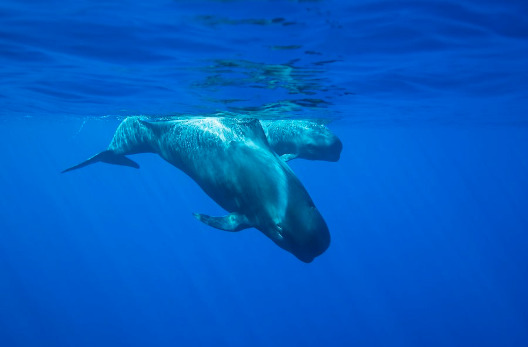
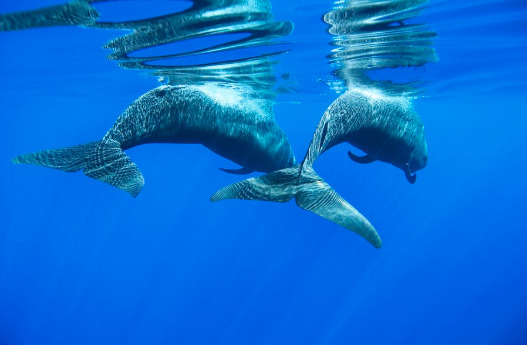
Short-Finned Pilot Whales
Globicephala macrorhynchus
#pilot whales#short-finned pilot whales#whales#toothed whales#pod#whale pod#globicephala#globicephala macrorhynchus#cetaceans#cetacea#animalia#mammalia#marine life#marine biology#mammals#marine photography#nature#nature photography#animals#animal photography#flukes#fins#delphinidae#dolphins#atriodactyla#ungulates#pretty#underwater#cool
10 notes
·
View notes
Text

Long-finned Pilot Whale
Globicephala melas melas
Family: Delphinidae
Genus: Globicephala
Conservation Status: Least Concern
This whale is not a whale but a large dolphin. Despite the minimal differences between the Short-finned Pilot Whale and this species, they are indeed two distinct species. If that is not perplexing enough, this dolphin also possesses one subspecies—actually two, although one became extinct long ago along the coasts of Japan. In fact, scientists aren't sure that was a subspecies but almost sure. Let's say %93,2 sure.
You see, science is consistently regarded as an exact discipline.
Consider joining the club here.
No money? No problem. Follows, likes and shares will help too.
Hasta la vista.
#Long finned Pilot Whale#pilot whales#whales#dolphins#illustration#drawing#scientific illustration#illo#wild animals#wildlife#animals#artist on tumblr#mammals#whale#conservation#endangered species#extinction
34 notes
·
View notes
Photo

HD, alta definición 🏋🏻♀️ No hagáis caso de la calidad de la foto, te tiembla el pulso cuando lo das todo entrenando 🙃 #biceps #bicepsworkout #bicepsday #globicephala #medicalbiceps #doublebiceps #globicephalamelas #bicepworkout #feelmybicep #doblebiceps (en Basic-Fit) https://www.instagram.com/p/CDwim2EjB47/?igshid=yl0ioh05t2pw
#biceps#bicepsworkout#bicepsday#globicephala#medicalbiceps#doublebiceps#globicephalamelas#bicepworkout#feelmybicep#doblebiceps
0 notes